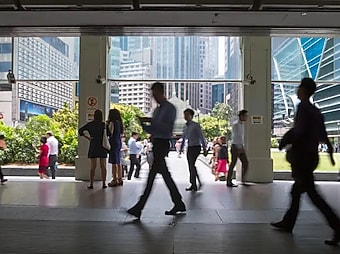The Office Real Estate Crash Will Be Bad
Worse Than The Global Financial Crisis Decline
The vacancy rate is huge in office buildings, partly due to more people working from home. Bonds backed by commercial real estate loans could be the next pain point for markets, economist says. Risky commercial real estate investments are getting squeezed as the market collapses. Office owners are on ‘borrowed time’ as maturing debts can’t be pushed off much longer, Goldman Sachs says
The looming office-real-estate crash will be worse than the Global Financial Crisis decline, Fitch says
- The decline of office values could match or exceed 2008-era depreciation, Fitch Ratings said.
- If office real estate were to recover, it would be a more protracted rebound.
- The delinquency rate of mortgage-backed securities backed by office loans will more than double this year.



Singapore claims to have access to world-class talent. One executive living and working here for 17 years shares why this is true.
The plunge in US office values could match or exceed 2008’s real estate fallout, as prices have yet to bottom out, Fitch Ratings wrote in a note on Wednesday.
Office values have dropped an estimated 35% so far this cycle. While that’s still above the 47% plunge witnessed during the Great Financial Crisis, the latest situation offers no reason to expect the descent to slow.
“In contrast, property values had recovered to roughly 80% of their pre-crisis peak in this same timeframe following the GFC, having regained approximately half of their value declines,” the ratings agency wrote.
Related stories
Bonds backed by commercial real estate loans could be the next pain point for markets, economist says
Risky commercial real estate investments are getting squeezed as the market collapses
Office owners are on ‘borrowed time’ as maturing debts can’t be pushed off much longer, Goldman Sachs says
Instead, current values are near a four-year low, and Fitch expects any future recovery to be more protracted than what followed the 2008 crash. Extending the timeline is the endurance of remote work trends, bleak refinancing conditions, and significantly higher interest rates.
According to Goldman Sachs estimates from late 2023, the share of US workers still working from home is in the range of 20%-25%, significantly slashing the need for office space.
These factors could permanently diminish property valuations and spark higher-than-expected losses on commercial mortgage-backed securities backed by loans on office properties.
Fitch expects the CMBS delinquency rate to jump above the post-GFC peak. This year, the rate will jump from February’s 3.6% to 8.1%, the agency said, before hitting 9.9% in 2025.
“CMBS defaulted conduit office loans has increased since 2020, stretching beyond four years in 2022 compared to the pre-pandemic average of approximately 2.5 years between 2009 and 2019, indicating property liquidations and the realization of losses for office loans currently in default could play out through 2028 and beyond,” Fitch said.
Office sector challenges are part of broader distress in the commercial real estate space. Prices are facing their steepest drop-off in the last-half century, the IMF warned in January, as higher borrowing costs erode the availability of financing to the sector.
Falling values and more expensive borrowing costs have caused many property owners to negotiate extensions of their loans past their original maturity date. But this may only be delaying an eventual crash, analysts have warned, with a $2.2 trillion wave of commercial real-estate debt set to mature in 2027. Goldman Sachs wrote this week that the trend of extending and modifying commercial mortgages can’t continue much longer.
Meanwhile, delinquent loans are already making up a larger portion of collateralized loan obligations, an investment product that groups riskier commercial real-estate debt. CLO distress rocketed 440% higher in the 12 months ahead of January.
